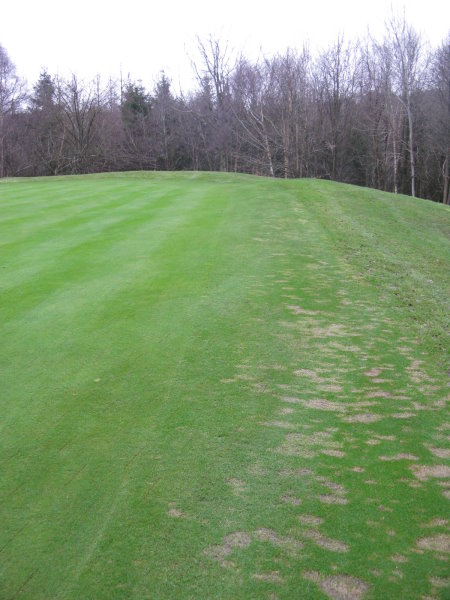
As autumn closes in, the combination of residual summer warmth and late season humidity suggests the onset of Fusarium Patch is not far away. The very fact that the disease caused by the fungal pathogen Michrodochium nivale tends to be common at the same period each season means we can prepare in advance for its arrival; minimise its effect and limit the input of pesticides if we take a longer term view.
A programme to maximise plant health, going into and during this autumn period, can have a hugely positive effect on reducing the incidence of turf disease. This approach takes a longer term, strategic view of turf management using preventative applications of plant elicitors and plant hardeners, applied prior to the main disease period rather than relying solely on costly repeated fungicide applications.
The programme utilises a tank-mix application of three liquid plant health products alongside a liquid fertiliser. Of the plant health products, Liquid Turf Hardener is a calcium based plant hardener that helps increase cell wall thickness. Seamac ProTurf is a citrate chelated iron formulation that also hardens cells and creates an acidic leaf environment, and Turfite is a phosphite liquid, formulated to trigger the natural defence mechanism of the plant (SAR or Systemic Acquired Resistance) aiding plant growth even in the presence of a pathogen. The combination of these three products applied prior to the onset of disease, at rates of 20L/Ha (Liquid Turf Hardener), 20L/Ha (Turfite) and 30L/Ha (Seamac ProTurf) – hence ‘20/20/30’ mix, has shown to be the most beneficial in helping to minimise the effects of Microdochium nivale over the autumn/winter period. The 20/20/30 approach is based on helping the plant to defend itself more efficiently from disease.
Control of dew is a key element of disease control on fine turf as Microdochium nivale moves in water. Dew formation begins in the early hours so it is not always possibleto remove it by physical means. STRI trials have shown considerable success using the plant surfactant Dewcure, which can be effective for up to four weeks in lower temperatures. As with most things, timing is the key. If Microdochium nivale is kept in check, and not allowed to proliferate, then a much healthier sward is evident going into the new season. Any significant level of disease reduction might result in a reducing need for fungicide.
Whiteleaf Golf Club encountered a situation during the winter when the greens were very high in thatch and very susceptible to disease. They were finding the high pressure periods of disease to be September and October due to the high moisture levels mixed with warm conditions. They had difficultly to get the plant strong enough and found they had to spray a lot to try and keep the disease at bay. Mike Ginger, Head Greenkeeper, went to Iain Richardson from Headland to improve plant health as well as reducing the costs they were spending on fungicides. “We started to use the 20/20/30 programme over 5 years ago,” he says, “and have more than halved our fungicide bill. It also means that after the winter months we have superb plant health and minimal susceptibility to disease. The plant comes out of winter ready and raring to go into summer – it’s amazing. Every year it seems to get stronger and stronger. Using 20/20/30 seems to have given the plant its own immune system to fend off the disease.”
Mike Gould, Head Greenkeeper over at the Copthorne Golf Club in West Sussex is a new convert who only started using 20/20/30 about a year ago. “We seemed to be using excessive amounts of fungicide – spraying 8 times in 2013,” he says. “With the use of 20/20/30 we have already seen a considerable drop in the amount of disease spraying we had to do which is a huge saving in cost and labour. It’s only a year since we started the programme but we’re delighted with the results we’re getting.”
20/20/30 represents a preventative approach rather than a curative strategy – fungicide may still be needed if any residual disease becomes evident. But even in this case, overall costs can be considerably lower – up to 50 per cent less than using fungicide alone, and as the products being applied are nutrients rather than pesticides, the impact on the environment is reduced, whilst turf quality can more often be enhanced.
Headland Amenity www.headlandamenity.com

